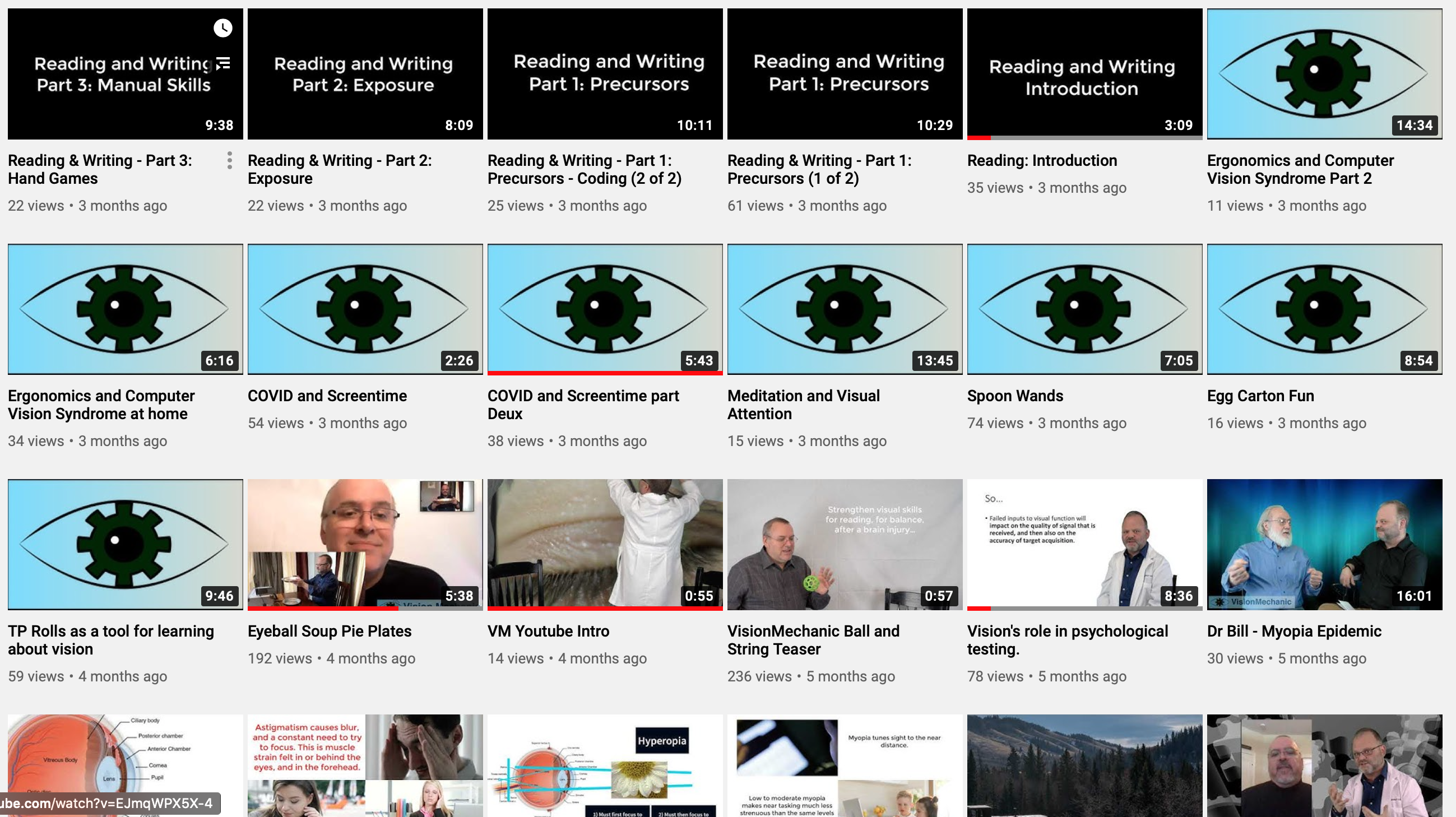 Subscribe to Vision Mechanic on YouTube.com
Subscribe to Vision Mechanic on YouTube.com
(The goal of VisionMechanic.net is to provide science-based clinically relevant resources about humans, for humans. All humans. This series highlighting International Vision and Learning Month (August) is more focused on those humans who are in formal learning programs, most notably, younger humans. If you yourself are a learner, or if you teach them, guide them, care for them or provide therapy for them, then this series will be of interest to you.)
The last post presented a very brief overview of some elements of the eye and how the eye plays into human vision. (See Adler’s Physiology of the Eye, or Principles of Neural Science, or Visual Perception: A Clinical Orientation for more details.) The conclusion was pretty simple: Sometimes the ‘eye-camera’ does not work well and this leads to blur, discomfort, pain, and in some cases blindness. Also, it is not the camera that drives the process, it’s the photographer.
One of the most important elements in vision is the simple clarity of sight, what is sometimes described as visual acuity. Eye charts are used to measure this at different distances. The eye’s focusing muscle, the ciliary body, is called into action whenever there is perception of blur: Focusing light through this mechanism can only go in one direction, that is to bring focus closer to us. Relaxing the mechanism (the ciliary muscle) moves focus away from us to more distant targets. Keep this in mind: It takes effort to move focus in, and we have to relax to move focus away from us again.
In the optical world, that is, the world we look at, light rays coming at us from a distance (say, the horizon) are effectively parallel rays, they are said to be collimated. The front of the eye (anterior segment) must take these parallel rays and focus them on a screen (the retinal receptor cell layer) a mere 17-24mm away. The size of the eyeball, or globe, will determine how much focusing power is needed: Smaller eyes need more focusing power because the ‘screen’ is closer in and focusing power must be applied to bend the light rays even more. If the eye is too big, the light rays will be focused before they hit the receptor cell layer. If the eye is perfectly balanced for focus, it will see the distant horizon clearly with no effort. This condition is called emmetropia, or ‘neutral sightedness’.
Where the eye naturally focuses light while at rest is called the refractive state, sometimes called the refractive error. Any variance from perfect alignment of focus on the retinal cell layer will lead to blur, and blur triggers the focusing mechanism to try to clear the image.
Emmetropia is a state where looking in the distance is relaxed, and no effort is required to see at distance. Focusing effort will be required to see nearer targets clearly. People who are emmetropic generally will not complain about blur issues until they reach their early 40’s when the focusing power of the lens reduces to a point of being noticed. If you are nearsighted, farsighted, or have astigmatism, you will struggle with blur and strain on your focusing muscles, in different ways, and this all depends on what you’re doing. For children, describing this is nearly impossible since, among other reasons, they feel their state of being is normal.
…there are different reasons for blur, these cover only a few. Ongoing blur is usually accompanied with strain, and both will impact on learning and development. The videos that follow explain more.
Most people have heard the following terms in their lifetimes but may not be able to describe them. Remember, there are different reasons for blur, these cover only a few. Ongoing blur is usually accompanied with strain, and both will impact on learning and development. The videos that follow explain more.
Nearsighted (Myopia): The eye naturally over-focuses light rays so that things in the near distance are clear, but distant objects are blurry. When in focus, targets appear clear, sharp – there is always a point in front of a nearsighted person where objects appear in focus. Nearsighted people do well with near tasking because focusing is physically easier for them. Nearsightedness over 1.00D should generally be compensated for in adults and children alike. Paradoxically, since nearsightedness helps with near work, wearing glasses in these cases takes away the advantage for working at near distances.
Farsighted (Hyperopia): The eye under-focuses light rays and must provide additional focusing support by means of muscle effort – the ciliary body is the muscle that provides this effort. The constant strain to focus is made worse with nearer targets and with more detailed work, such as reading. While there is a point where the farsighted eye can make an image clear, the focusing force required to do so in most cases is felt as strain or pain, and often the eye simply relaxes to regain some comfort. Farsightedness is a common cause of apparent learning and behaviour problems. Anything over 1.50D of farsightedness should be compensated for in most people, including kids in school.
Farsightedness is a common cause of apparent learning and behaviour problems. Anything over 1.50D of farsightedness should be compensated for in most people, including kids in school.
Astigmatism (Toricity/Cylinder): Astigmatism is an optical folding of the collimated / parallel rays coming at us. The shape of the eye is such that it cannot focus light rays on one plane, but stretches it across two planes. The astigmatic eye, like the farsighted eye, NEVER relaxes as it tries to make sense of an optical signal that cannot be made clear without additional help. Astigmatism, like farsightedness, is a common cause of learning and behaviour concerns that goes undetected. Any astigmatism over 0.75D should be compensated.
These are the three basic flavours of refractive state, but it gets a bit more complicated still. So, for example, one eye might be nearsighted and the other farsighted (antimetropia), or one eye image might be magnified more than the other eye (aniseikonic), or there might be a great difference in refractive state between the eyes (anisometropia). These topics, and others, are beyond the scope of this short post but readers can follow the links to learn more.
The point is this: Blur is important, but invisible to the outsider. Children not only see blur, but they feel it, yet they cannot report this back to adults for lack of common language, and because they most often do not know their vision and sight are problematic. Adults see the effects of unhelpful refractive states, but without knowing the details, inappropriate treatments and testing can be applied to no avail, or worse, they can lead to harm.
When it comes to dealing with child behaviour, learning, and developmental concerns, it’s best to follow the advice of my professors: If the bushes are rustling, think racoon before unicorn. In the world of child development, learning, and paediatrics, there is a need to also start with obvious things, and refractive state is a good place to look first.
Further posts will review other elements of vision function and how these can affect child behaviour and development.
Expand your understanding:
- Get a head start by having a look at other posts here at visionmechanic.net, or on the Vision Mechanic YouTube channel.
- Learn more in a more formal way, consider taking one of the growing number of professional credit VisionMechanic.net courses for developmental professionals (teachers, doctors, therapists, psychologists).
- Join the Vision Rehabilitation Group on FaceBook.







2 Responses
can antimetopia have a relationship with (functional dyslexia???
Reading problems are not uncommon with vision problems but true dyslexia is issue of decoding and encoding letters and sounds. While many people with dyslexia also have ocular motor problems, improving the ocular motor skills will not improve the language issues associated with developmental dyslexia.